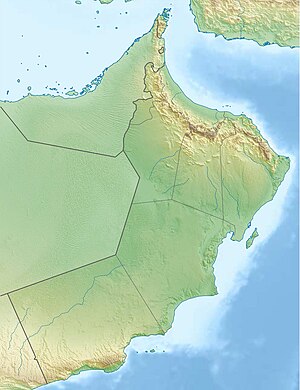Nizwa Fortress
| Nizwa Fortress | ||
|---|---|---|
|
Main tower of the fortress with the entrance to the complex on the left |
||
| Alternative name (s): | قلعة نزوى | |
| Creation time : | 1650s | |
| Geographical location | 22 ° 56 '0 " N , 57 ° 31' 49" E | |
|
|
||
The fortress of Nizwa ( Arabic قلعة نزوى, DMG Qalʿat Nizwā ) is a large fortress in Nizwa , an oasis city in the center of Oman .
history
Since the beginning of the 17th century, Nizwa was the capital of the Yaruba dynasty . The fortress of Nizwa was built in the 1650s under the rule of Sultan ibn Saif I , but the foundations go back to the 12th century.
The fortress was the administrative seat for the Imams and Wālī of the region. The walls and buildings were erected over an underground watercourse over the course of twelve years and, with their large dimensions for Omani standards, are a reminder of the importance of the city in the turbulent history of Oman. The tall walls acted as protection from raids, attracted by the city's wealth at the crossroads of numerous trade routes.
investment
The fortress of Nizwa borders on the east of the large souk of the oasis in the north of the fortified residential area of the oasis. It demonstrates the progress in fortress building in the Yaruba dynasty and the transition to mortar-based warfare. The thick foundations of the fortress, in turn, extend 30 meters into the ground. The reinforced doors and walls are all rounded and sturdy to withstand mortar fire even during lengthy conflicts.
The complex and the whole city is taken up by a 24 meter high main tower with a diameter of 45 meters. This is mostly filled with rocks and rubble up to a height of 14 meters. On top of it lies the cannon platform, which is protected by a wall more than ten meters high with a palisade . In the main tower there are 24 openings for the mortars stationed there, which could return fire if attacked from any direction. Of the original 24 mortars, only four are still on the main tower. One of the mortars bears the name of Sultan bin Saif . Another cannon was a gift from Boston , given to the first Oman ambassador to the United States in 1840. The architecture of the main tower with battlements, secret passages, trap doors and fountains testifies to the intention to be able to offer long-term resistance against attackers.
In front of the complex is a courtyard with high walls, but with several entrances. Behind the main entrance to the fortress building, which consists of a living area next to the tower, a labyrinth of corridors, gates, courtyards, rooms, terraces, halls and narrow staircases and passages opens up. The location of the fortress above an underground river and the cisterns supplied with it ensured the water supply in times of siege.
The only access to the upper part of the main tower was via a narrow, winding staircase in the dark interior of the tower, which was blocked by a heavy, spiked wooden door. Traps in the stairwell let hot oil or water rain down on enemies through killer holes . Six pitfalls made it difficult to access the tower - some stairs still have wooden boards that could be removed in an emergency to open a deep shaft. Underground cellars were intended for the supply of food and ammunition. 120 guards could be stationed at the same time on the battlements of the main tower; 480 gun openings were added.
tourism
The fortress now houses a museum that explains the history, crafts and traditions of Nizwa. Opening times are limited on Friday.
Nizwa Souk and Fortress are one of the most visited tourist attractions in Oman.
literature
- Ministry of National Heritage and Culture: Nizwa Fort . Ministry of National Heritage and Culture, Muscat 1990, OCLC 51524250 .
Web links
- Fort of Nizwa on Oman Tourism
- Detailed description with numerous plans, sketches and photos , made for the Times of Oman (2011) (English)
- Video about the fortress
Individual evidence
- ↑ a b c d e Kirstin Kabasci, Peter Franzisky: Oman . 10th edition. Reise Know-how, Bielefeld 2017, ISBN 978-3-8317-2824-4 , p. 127 f .
- ↑ Jenny Walker: Al-Dakhiliyah Region: Nizwa: Sights: Nizwa Fort. In: Oman, UAE & Arabian Peninsula. 2nd Edition. Lonely Planet , Footscray, Victoria, Australia 2007, ISBN 978-1-74104-546-8 , p. 232. (books.google.com)
- ↑ a b c Peter J. Ochs: Maverick Guide to Oman. 2nd Edition. Pelican Publications, Gretna, Louisiana, USA 2000, ISBN 1-56554-687-3 , p. 275. (books.google.com)
- ^ A b Diana Darke, Sandra Shields: Nizwa Fort. In: Oman: The Bradt Travel Guide. Bradt Travel Guides, Chalfont St. Peter, Buckinghamshire 2006, ISBN 1-84162-168-4 , p. 191. (books.google.com)
- Jump up ↑ Fort of Nizwa. In: Oman Tourism. Ministry of Tourism, accessed November 7, 2019 .
- ^ Antonio Farach: The Great Fort of Nizwa. In: Behance.net. May 17, 2016, accessed November 6, 2019 .
- ^ Percy Cox: Some Excursions in Oman. In: The Geographical Journal. Volume 66, No. 3, 1925, pp. 193-221, p. 215.




